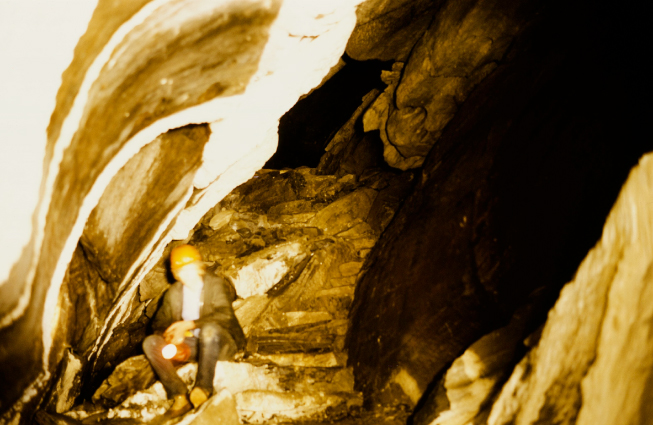
Of all my youthful adventures around Revelstoke, exploring the Nakimu Caves in Glacier Park stands out. They are so mysterious and so unusual that friends and I explored them several times in the summers of 1970 and ’71. Nowadays, access is denied except by permit, but two upcoming trips are being offered which I’ll mention later.
Probably I first learned of these caves from a university lecture. Once we knew the deepest cave system in Canada was practically in our backyard, the idea was irresistible to my band of fellow adventurers. The Nakimu — it sounds as exotic as the Hindu Kush, Torres del Paine, or the Bugaboos — other mountain regions of international repute. In Shuswap dialect, it means “grumbling spirits.” The name was applied by prospector/trapper Charles Deutschmann, who discovered the caves in 1904. It was inspired by the subterranean rumble of Cougar Creek, which carved the caves through tilted limestone beds, and which continues to erode passages too deep to explore.
In describing that exploit, Arthur Wheeler, the famed mountaineer and surveyor, wrote of Deutschmann:
It… shows a character utterly devoid of fear. The descent into depths of blackest darkness, lighted only by dim rays of a tallow dip, without rope or other aid except in the case of direst necessity, requires more than courage: it requires strength of purpose and power of will beyond the ordinary degree. For, added to the darkness, there was always the fierce vibrating roar of subterranean torrents, a sound most nerve shaking in a position sufficiently uncanny and demoralizing without it. Huge cracks have to be crossed, and precipitous descents made in pitch darkness, where it is safe to say, misstep would have meant death…
Deutschmann constructed wooden walkways and staircases, and even a floating bridge, to facilitate visitors. In ‘Subway Passage’, he blasted a trench 110 meters long to enable guests to walk rather than crawl. In 1909, just over 1,000 people visited the caves, but with the closing of Glacier House in 1925, these numbers abruptly declined. No one was interested in cave exploration when Parks closed the Nakimu to the public in 1935. Closed and unpublicized, we noted, but not inaccessible…
Our first party contained Ron Fujino, Gordon Jones, Chris Kelly, plus myself; all RSS grads of ‘69. We equipped ourselves for an overnight hike because we wanted as much time underground as possible; the first day to ascend Cougar Creek and reconnoiter the multiple cave entrances; the second to explore and to escape. Casual use of Cougar valley for recreation was discontinued in 1996 due to bears. Radio-collar studies showed this area is prime habitat for female grizzlies. Today, the caves are barricaded and locked as well.

Not knowing this at the time, we made our way happily along the former wagon road which took sightseers from Glacier House to the caves, where they once enjoyed a decent cuppa in a teahouse served by seasonal staff. We made camp right before the main entrance. A steady, cool breeze issued from within — the internal temperature of the cave is 5˚C.
Peering within, we saw remnants of wooden staircases and ladders. It was akin to passing through the portal of the Mines of Moria (Tolkien’s Fellowship of the Ring). We dug lights out of our backpacks, two of which were antique lanterns owned by Gordon. These devices create acetylene for illumination. The gas is burned as an open flame at the centre of a parabolic reflector, which intensifies and casts a wider field of light. Acetylene is generated within the lamp by dripping water into a tank containing dry calcium carbide nuggets. The rate of generation can be controlled by the flow, and if the flame goes out, a simple scratch of an attached flint lights it again. Ingenious! It meant our time underground was not limited by battery duration.
One fascinating feature of the Nakimu is ‘moonmilk’ which has the appearance of cottage cheese. Thought to be caused by calcium carbonate crystals growing on bacteria, it is soft and fragile. The white ‘lime’ precipitates from water sheeting thinly over the ceiling and walls. Yet in other places, the expected hard stalactites form from dripping points. Should water drain along a protruding overhead edge, its calcium tends to layer into thin horizontal ribbons called “cave bacon.” Such features are uncommon however, because the caves are relatively young.
Mostly we found rooms and passageways where we could walk with good headspace, but little larger than the average bungalow. The floors of these spaces were often covered with rubble from ceiling collapses. This gave many places angular, more mine-like appearances than the classic smooth-walled caverns of more famous formations. All of the system has been given names such as Terror Chamber and Perseverance Passage. At The Gimlet, we squeezed into a smooth-walled slot resulting from recent water erosion. Sometimes such slots opened in the floor, to depths which our lights couldn’t penetrate.
Stream flow is largely reduced as winter freezes this subalpine region. When we reached the end of our route in the Witches Ballroom, we found it filled with ice. It results from cold air and water entering from an exterior gorge, and it takes all summer to melt. Chris Kelly recently wrote of his experience: “Two things I will always remember were the smell of the acetylene headlamps and the four-ton block of ice we found inside the caves. I still remember the instant headache when we drank water off the top of it.”
The Nakimu was the start of other subterranean explorations for several of us — we went on to abandoned mines and caves elsewhere in the province over the next several years. Like the Hardy Boys, we did it all without mishap (or permission!). Our youth in Revelstoke surely allowed freedom and opportunity for adventure which can be rarely matched by any other time or place in B.C.
Nakimu trips being offered by FMRG
The Friends of Mount Revelstoke and Glacier National Parks is putting on trips to Nakimu Caves. Space is available on August 25 and September 8. Payment is $120 for non-members. For more details, see their advertisement on The Current’s front page.
© Tom W. Parkin
Tom Parkin is widely-published author, photographer and Revelstoke Secondary School grad of ’69. He actually breaks rocks for a living now — as a self-employed stonemason in Nanaimo, BC. Visit his website atwww.ssmasonry.ca. You can contact Tom at twparkin@ssmasonry.ca



